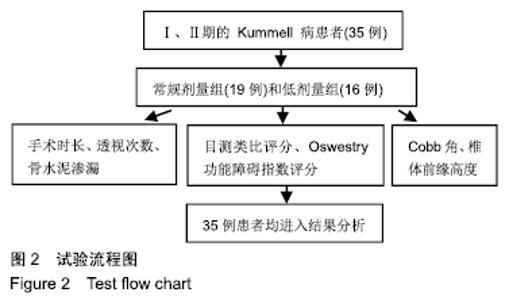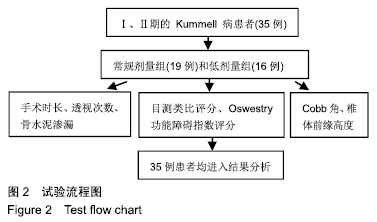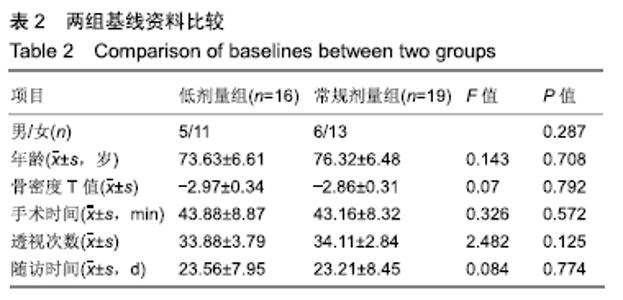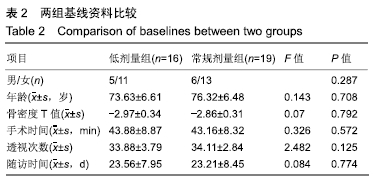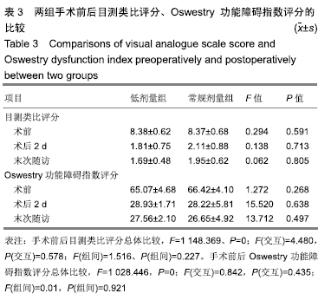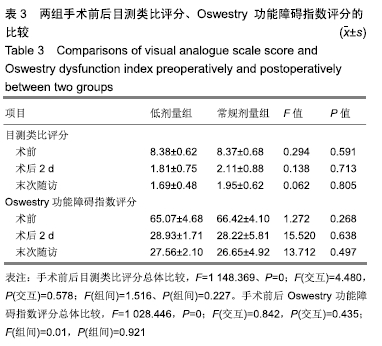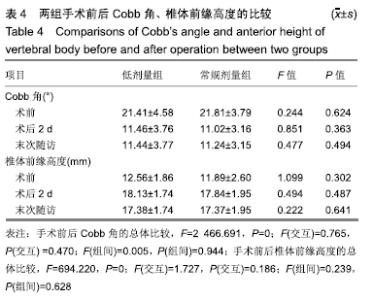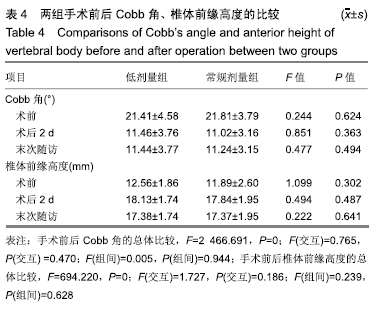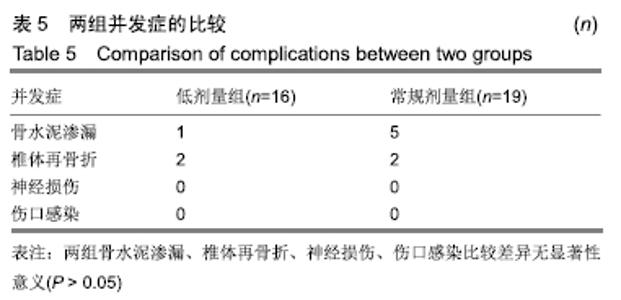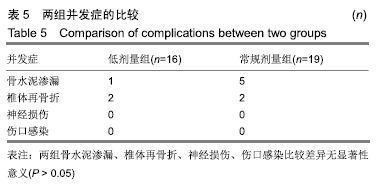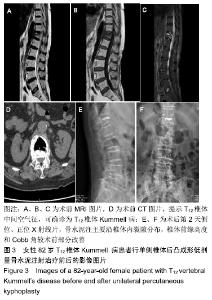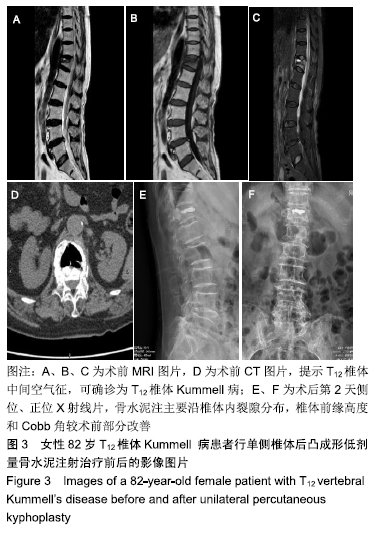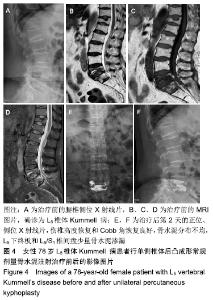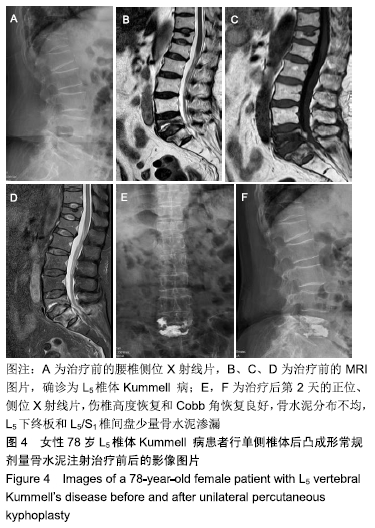Chinese Journal of Tissue Engineering Research ›› 2020, Vol. 24 ›› Issue (16): 2467-2472.doi: 10.3969/j.issn.2095-4344.2252
Previous Articles Next Articles
Relationship between unilateral percutaneous kyphoplasty for treating Kummell’s disease and the amount of injected bone cement
Ren Yide1, Zhang Yafeng2, Li Feng1, Gao Hongwen1
- 1Department of Orthopedics, Wuxi Huishan District Hospital of Traditional Chinese Medicine, Wuxi 214000, Jiangsu Province, China; 2Department of Orthopedics, Wuxi Hospital of Traditional Chinese Medicine, Wuxi 214000, Jiangsu Province, China
-
Received:2019-07-23Revised:2019-07-27Accepted:2019-09-21Online:2020-06-08Published:2020-03-24 -
Contact:Zhang Yafeng, Chief physician, Department of Orthopedics, Wuxi Hospital of Traditional Chinese Medicine, Wuxi 214000, Jiangsu Province, China -
About author:Ren Yide, Master, Physician, Department of Orthopedics, Wuxi Huishan District Hospital of Traditional Chinese Medicine, Wuxi 214000, Jiangsu Province, China -
Supported by:the National Natural Science Foundation of China, No. 81473693
CLC Number:
Cite this article
Ren Yide, Zhang Yafeng, Li Feng, Gao Hongwen. Relationship between unilateral percutaneous kyphoplasty for treating Kummell’s disease and the amount of injected bone cement[J]. Chinese Journal of Tissue Engineering Research, 2020, 24(16): 2467-2472.
share this article
| [1] LI KC, LI AF, HSIEH CH, et al.Another option to treat Kümmell's disease with cord compression.Eur Spine J.2007;16(9):1479-1487. [2] LEE K, ADSUL N, KIM HS, et al. Percutaneous Pedicle Screw Fixation with Bone Cement Augmentation Under Epidural Anesthesia for Treatment of Kümmell Disease in Extremely Old Age.World Neurosurg. 2018;119 506-510. [3] HUANG YS, HAO DJ, WANG XD, et al.Long-Segment or Bone Cement-Augmented Short-Segment Fixation for Kummell Disease with Neurologic Deficits? A Comparative Cohort Study.World Neurosurg.2018;116:e1079-e1086. [4] HUANG YS, HAO DJ, FENG H, et al.Comparison of Percutaneous Kyphoplasty and Bone Cement-Augmented Short-Segment Pedicle Screw Fixation for Management of Kümmell Disease.Med Sci Monit. 2018;24:1072-1079. [5] HUANG YS, GE CY, FENG H, et al.Bone Cement-Augmented Short-Segment Pedicle Screw Fixation for Kümmell Disease with Spinal Canal Stenosis.Med Sci Monit.2018;24:928-935. [6] CHO Y.Posterior Vertebrectomy and Circumferential Fusion for the Treatment of Advanced Thoracolumbar Kümmell Disease with Neurologic Deficit.Asian Spine J.2017;11(4):634-640. [7] ORCHOWSKI J, BRIDWELL KH, LENKE LG.Neurological Deficit From a Purely Vascular Etiology After Unilateral Vessel Ligation During Anterior Thoracolumbar Fusion of the Spine.Spine(Phila Pa 1976). 2005;30(4):406-410. [8] MARIE PJ, KASSEM M.Osteoblasts in osteoporosis: past, emerging, and future anabolic targets. Eur J Endocrinol.2011;165(1):1-10. [9] LI H, LIANG CZ, SHEN CC, et al.Decreases in fluid shear stress due to microcracks: a possible primary pathogenesis of Kümmell's disease. Med Hypotheses.2011;77(5):897-899. [10] MATZAROGLOU C, GEORGIOU CS, ASSIMAKOPOULOS K, et al. Kümmell's disease: Pathophysiology, diagnosis, treatment and the role of nuclear medicine. Rationale according to our experience. Hell J Nucl Med.2011;14(3):291-299. [11] MATZAROGLOU C, GEORGIOU CS, ASSIMAKOPOULOS K, et al. Kummell' s disease: A rare spine entity in a young adult.Hell J Nucl Med.2010;13(1):52-55. [12] LIANG L, CHEN X, JIANG W, et al.Balloon kyphoplasty or percutaneous vertebroplasty for osteoporotic vertebral compression fracture? An updated systematic review and meta-analysis. Ann Saudi Med. 2016;36(3):165. [13] 蒋杰,张勇.单侧穿刺经皮椎体后凸成形与椎体成形骨水泥注射治疗Kummell病的对比[J].中国组织工程研究,2019,23(22):3481-3487. [14] 张蓉,周文雅,刘平,等.经皮椎体成形术与经皮球囊扩张椎体后凸成形术治疗中国人Kümmell's病疗效的Meta分析[J].中华老年病研究电子杂志, 2019,6(1):33-40. [15] REBOLLEDO BJ.Comparison of unipedicular and bipedicular balloon kyphoplasty for the treatment of osteoporotic vertebral compression fractures: a prospective randomised study.Bone Joint J. 2013;11(3): 401-406. [16] FRANKEL BM, MONROE T, WANG C. Percutaneous vertebral augmentation: an elevation in adjacent-level fracture risk in kyphoplasty as compared with vertebroplasty.Spine J.2007; 7(5):575-582. [17] XU JC, WU GH, ZHOU LL, et al.Two unilateral puncturation comparative analyses of multiple-level fresh osteoporotic vertebral body compression fractures treated with percutaneous vertebroplasty guided by C-arm fluoroscopy or in senile patients.Eur Rev Med Pharmacol Sci. 2017;21: 1456-1461. [18] YAN L, HE B, GUO H, et al.The prospective self-controlled study of unilateral transverse process-pedicle and bilateral puncture techniques in percutaneous kyphoplasty.Osteoporosis Int.2016;27(5):1849-1855. [19] SUN YL, XIONG XM, WAN D, et al.Effectiveness comparison between unilateral and bilateral percutaneous kyphoplasty for Kümmell disease.Zhongguo Xiu Fu Chong Jian Wai Ke Za Zhi.2017; 31: 1086-1091. [20] PIAO M, DARWONO AB, ZHU K, et al.Extrapendicular Approach of Unilateral Percutaneous Vesselplasty for the Treatment of Kummell Disease.Int J Spine Surg.2019;13:199-204. [21] MOLLOY S, MATHIS JM, BELKOFF SM.The Effect of Vertebral Body Percentage Fill on Mechanical Behavior During Percutaneous Vertebroplasty.Spine (Phila Pa 1976).2003;28(14):1549-1554. [22] 徐磊,杨惠林,姜为民,等.单侧经皮聚甲基丙烯酸甲酯骨水泥椎体成形治疗中骨水泥注入位置、注入量与疗效的相关性[J].中国组织工程研究, 2012, 16(21):3833-3837. [23] LIN JC, QIAN L, JIANG CQ, et al.Bone cement distribution is a potential predictor to the reconstructive effects of unilateral percutaneous kyphoplasty in OVCFs: a retrospective study. J Orthop Surg Res. 2018;13(1):140. [24] LI HK, HAO DJ, YANG JS, et al.Percutaneous kyphoplasty versus posterior spinal fixation with vertebroplasty for treatment of Kümmell disease.Medicine.2017;96(51):e9287. [25] KAUFMANN TJ, TROUT AT, KALLMES DF.The Effects of cement volume on clinical outcomes of percutaneous vertebroplasty.Am J Neuroradiol.2006;27(9):1933-1937. [26] FU Z, HU X, WU Y, et al.Is There a Dose–Response Relationship of Cement Volume With Cement Leakage and Pain Relief After Vertebroplasty?Dose Response.2016;14(4):1559325816682867. [27] 刘澎,高利颖,孙祯杰,等.高黏度骨水泥行PKP治疗Kummell病的疗效分析[J].创伤外科杂志,2019,21(5):388-389. [28] 曾森炎,季卫锋,董玉鹏,等.高粘度与低粘度骨水泥PVP治疗骨质疏松性椎体压缩骨折的Meta分析[J].中国骨与关节损伤杂志,2018,33(3):240-243. [29] LIU T, LI Z, SU Q, et al.Cement leakage in osteoporotic vertebral compression fractures with cortical defect using high-viscosity bone cement during unilateral percutaneous kyphoplasty surgery.Medicine. 2017;96(25):e7216. [30] NIEUWENHUIJSE MJ, ERKEL AV, DIJKSTRA PD.Cement leakage in percutaneous vertebroplasty for osteoporotic vertebral compression fractures: identification of risk factors.Spine J.2011;11(9):939-848. [31] ZHAN Y, JIANG J, LIAO H, et al.Risk Factors for Cement Leakage After Vertebroplasty or Kyphoplasty: A Meta-Analysis of Published Evidence.World Neurosurg.2017;101:633-642. |
| [1] | Liu Jinlei, Yin Li, Zhang Yi, Wang Haitao, Li Zhuangyan, Xia Peige, Qiao Renqiu. Effects of intravenous tranexamic acid combined with periarticular multipoint injection of tranexamic acid cocktail on blood loss and pain after total knee arthroplasty [J]. Chinese Journal of Tissue Engineering Research, 2021, 25(18): 2833-2839. |
| [2] | Li Qiang, Li Jun, Luan Jian, Jin Canghai, Hao Meng, Lin Yong. Bone cement distribution of percutaneous curved vertebroplasty for the treatment of osteoporotic vertebral compression fractures [J]. Chinese Journal of Tissue Engineering Research, 2021, 25(16): 2466-2471. |
| [3] | Zhang Zhiwei, Li Li, Huang Ziyu, Wu Duoyi, Gan Farong, Ye Baofei, Zhang Yan, Zhang Taibiao, Hu Wanjun. Percutaneous vertebroplasty through unilateral and bilateral pedicle approaches and unilateral pedicle extrapedicle approach for the treatment of thoracolumbar vertebral compression fractures: bone cement perfusion volume and cement leakage rate [J]. Chinese Journal of Tissue Engineering Research, 2020, 24(9): 1353-1358. |
| [4] | Huang Yong, Zhu Weimin, Lu Wei, Ouyang Kan, Peng Liangquan, Liu Haifeng, Li Hao, Feng Wenzhe, Xu Jian, Zhong Mingjin, Chen Kang, Li Ying, Deng Zhenhan. Safety of steroid-containing cocktail periarticular injection after knee arthroplasty: a meta-analysis [J]. Chinese Journal of Tissue Engineering Research, 2020, 24(9): 1449-1456. |
| [5] | Zhan Fangbiao, Xie Lizhong, Zou Xinsen, Long Jie, Cheng Jun, Zhang Xianwei. Efficacy and safety of percutaneous kyphoplasty versus posterior short-segment fixation with vertebra augmentation for Kummell’s disease: a meta-analysis [J]. Chinese Journal of Tissue Engineering Research, 2020, 24(33): 5397-5404. |
| [6] | Deng Kaifeng, Chen Rilan, Zhu Shengwang, Wei Xingcheng, Zhang Lijuan, Zhu Ying. Electroacupuncture combined with thunder-fire moxibustion in the treatment of cold-dampness knee osteoarthritis: a randomized controlled clinical trial [J]. Chinese Journal of Tissue Engineering Research, 2020, 24(29): 4638-4642. |
| [7] | Xie Hui, Chen Haopeng, Wang Benjie, Fu Weimin, Zhao Dewei. Effect of different distribution types of bone cement after percutaneous kyphoplasty on osteoporotic vertebral compression fractures at different sites [J]. Chinese Journal of Tissue Engineering Research, 2020, 24(28): 4505-4510. |
| [8] | Yan Xianke. Total knee arthroplasty through a midvastus approach reduces postoperative adverse reactions and accelerates functional recovery of the knee [J]. Chinese Journal of Tissue Engineering Research, 2020, 24(21): 3336-3340. |
| [9] | Luo Wei, Chen Jianping, Sun Qianqian, Chen Chen, Li Hang, Ma Chenglong, Su Rui, Feng Xiaoyue, Sun Yurui. Facet joint injection versus percutaneous kyphoplasty for mild vertebral fragility fractures: rapid analgesia and restoration of spinal stability [J]. Chinese Journal of Tissue Engineering Research, 2020, 24(20): 3168-3173. |
| [10] |
Wang Mengran, Fu Zhiyi, Wang Huidong, Wu Yujie.
Efficacy and complications of different viscosities of high-dose
bone cement applied in percutaneous vertebroplasty |
| [11] | Jiang Wenkang, Geng Wei, Xu Yingying, Yang Xiaomei, Ren Hangling, Zhang Jingtao, Ma Jinzhu. Application of mineralized collagen modified bone cement in the treatment of osteoporotic vertebral compression fractures [J]. Chinese Journal of Tissue Engineering Research, 2020, 24(15): 2381-2386. |
| [12] | Li Fanjie, Du Yibin, Liu Yiming, Zhang Zhidong, Li Jian, Ma Li, Li Chun, Cheng Yonghong. Comparison of percutaneous vertebroplasty and percutaneous curved vertebroplasty for osteoporotic vertebral compression fractures: distribution and leakage rate of injected bone cement [J]. Chinese Journal of Tissue Engineering Research, 2020, 24(10): 1484-1490. |
| [13] | Li Shuyuan, Zhou Qishi, Li Yue, Lin Zhiyi, Zhou Hongliang, Shen Zhen, Hu Cheng, Yang Jiabao. Effects of changes in surface morphology of bone cement spacer on the expression of bone growth factor in induced membrane [J]. Chinese Journal of Tissue Engineering Research, 2020, 24(10): 1502-1507. |
| [14] | Wu Keliang1, Feng Wenjun2, Li Jie2, Zeng Jianchun2, Chen Jinlun2, Ye Pengcheng2, Jie Ke1, Zeng Yirong2 (1Guangzhou University of Chinese Medicine, Guangzhou 510405,. Effect of free iliac flap combined with vascularised greater trochanter bone grafting on preserving hip in young and middle-aged patients with ARCO III necrosis of the femoral head [J]. Chinese Journal of Tissue Engineering Research, 2019, 23(31): 4921-4926. |
| [15] |
Che Xianda, Han Pengfei, Gu Xiaodong, Gao Yangyang, Chen Taoyu, Li Pengcui.
Clinical outcomes of SuperPATH approach versus traditional posterior approach in total hip arthroplasty: a meta-analysis
[J]. Chinese Journal of Tissue Engineering Research, 2019, 23(24): 3901-3908.
|
| Viewed | ||||||
|
Full text |
|
|||||
|
Abstract |
|
|||||
